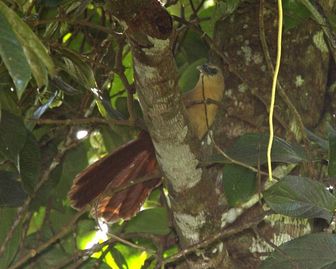Bay Coucal
Its natural habitats are subtropical or tropical moist lowland forests and subtropical or tropical moist montanes.

Original source: Lip Kee YapPermission(Reusing this file)This image, which was originally posted to Flickr.com, was uploaded to Commons using Flickr upload bot on 01:47, 6 April 2009 (UTC) by Rufous-crowned Sparrow (talk). On that date it was licensed under the license below. This file is licensed under the Creative Commons Attribution-Share Alike 2.0 Generic license.You are free:to share – to copy, distribute and transmit the work
Author: Lip Kee YapPermission(Reusing this file)This image, which was originally posted to Flickr.com, was uploaded to Commons using Flickr upload bot on 01:47, 6 April 2009 (UTC) by Rufous-crowned Sparrow (talk). On that date it was licensed under the license below. This file is licensed under the Creative Commons Attribution-Share Alike 2.0 Generic license.You are free:to share – to copy, distribute and transmit the work
The Bay Coucal is classified as Least Concern. Does not qualify for a more at risk category. Widespread and abundant taxa are included in this category.
The Bay Coucal (Centropus celebensis) is a species of cuckoo in the Cuculidae family. It is endemic to Indonesia. Its natural habitats are subtropical or tropical moist lowland forests and subtropical or tropical moist montanes. References - * BirdLife International 2004. Centropus celebensis. 2006 IUCN Red List of Threatened Species. Downloaded on 24 July 2007. This Cuculiformes-related article is a stub. More
* Bay Coucal, Centropus celebensis * Rufous Coucal, Centropus unirufus * Black-faced Coucal, Centropus melanops * Sunda Coucal, Centropus nigrorufus * Buff-headed Coucal, Centropus milo * Goliath Coucal, Centropus goliath * Violaceous Coucal, Centropus violaceus * Ivory-billed Coucal or Greater Black Coucal, Centropus menbeki * White-necked Coucal or Pied Coucal, Centropus ateralbus More
The Bay Coucal (Centropus celebensis) is a species of cuckoo in the Cuculidae family. It is endemic to Indonesia. Its natural habitats are subtropical or tropical moist lowland forests and subtropical or tropical moist montanes. More
Bay Coucal Centropus celebensis celebensis Bay Coucal Photographer : More
Bay Coucal calls and hoots, crickets in the background. Featured Libraries - BLASTWAVE FXBLASTWAVE FXmich3dmich3dAtomic PulseAtomic PulseFrank SerafineFrank SerafineSFX SourceSFX Source Latest sounds - 01 Flight of the Bea ...01 Flight of the Bea ...01 Flight of the Bea ... More
Bay Coucal, Centropus celebensis celebensis. July 10, 2006. Tangkoko, North Sulawesi, Indonesia. Habitat: Cultivated land at edge of forest. Source: Flickr (www.flickr.com/photos/lipkee/612273555/). Author: Lip Kee (www.flickr.com/photos/lipkee/). The Bay Coucal (Centropus celebensis) is a species of cuckoo in the Cuculidae family. It is endemic to Indonesia. Its natural habitats are subtropical or tropical moist lowland forests and subtropical or tropical moist montanes. http://en.wikipedia. More
Bay Coucal (Centropus celebensis celebensis) Source Collection Flickr Image Use creative commons This media file is licensed under the Creative Commons Attribution-NonCommercial-NoDerivs License - Version 2.0. Copyright © 2006 Lip Kee Yap About This Page Page copyright © 2007 Page: Tree of Life Centropus celebensis. Bay Coucal. More
* Bay Coucal, Centropus celebensis * Rufous Coucal, Centropus unirufus * Black-faced Coucal, Centropus melanops * Sunda Coucal, Centropus nigrorufus * Buff-headed Coucal, Centropus milo More
Bay Coucal Centropus celebensis Rufous Coucal Centropus unirufus Dwarf Cuckoo Coccyzus pumilus Ash-colored Cuckoo Coccyzus cinereus Black-billed Cuckoo Coccyzus erythropthalmus Yellow-billed Cuckoo Coccyzus americanus Pearly-breasted Cuckoo Coccyzus euleri Mangrove Cuckoo Coccyzus minor Cocos Cuckoo Coccyzus ferrugineus Dark-billed Cuckoo Coccyzus melacoryphus Grey-capped Cuckoo Coccyzus lansbergi Chestnut-bellied Cuckoo Hyetornis pluvialis Bay-breasted Cuckoo Hyetornis rufigularis Squirrel Cuckoo Piaya cayana Black-bellied Cuckoo Piaya melanogaster More
Bay Coucal Centropus celebensis Gabon Coucal Centropus anselli Black-throated Coucal Centropus leucogaster Senegal Coucal Centropus senegalensis Blue-headed Coucal Centropus monachus Coppery-tailed Coucal Centropus cupreicaudus White-browed Coucal Centropus superciliosus Sunda Coucal Centropus nigrorufus Greater Coucal Centropus sinensis Malagasy Coucal Centropus toulou Goliath Coucal Centropus goliath Black Coucal Centropus grillii Philippine Coucal Centropus viridis Lesser Coucal Centropus bengalensis Violet Coucal Centropus violaceus More
Bay Coucal Centropus celebensis 2009 IUCN Red List Category (as evaluated by BirdLife International - the official Red List Authority for birds for IUCN): Least Concern Justification This species has a very large range, and hence does not approach the thresholds for Vulnerable under the range size criterion (Extent of Occurrence 30% decline over ten years or three generations). More
Family : Cuculidae
Genus : Centropus
Species : celebensis
Authority : Quoy & Gaimard, 1830
